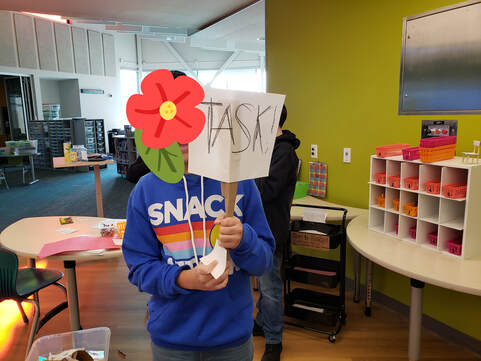|
At the beginning of every new semester, I (Jessi) have my middle school students fill out a notecard about themselves. It is a simple questionnaire with some basic and quirky tidbits, and serves as an icebreaker of sorts. Little did I anticipate the tremendous impact this simple activity would have in my classroom. I do tell my students that I share this information with the class before they fill out their cards but they are so eager for me to share their cards once they learn how the game works. (It is like Guess-Who.) Effective facilitation requires building a team that is positive and connected. When educators are developing a student-driven environment, it is vital that they facilitate team building just as a sports team coach builds and drives camaraderie. The notecard activity serves as a catalyst for student interaction and fosters genuine connections among peers. It becomes a foundation for building kindness by teaching students to have empathy and mindfulness. Designing Questions When crafting questions for students, start with the fundamentals such as birthdays and preferences. To spice things up, consider incorporating “would you rather” questions. Really there is no rule to designing the questions! Sample Questions:
How to Play Utilize any downtime or early clean-up moments in class to engage students with this game. Simply select a notecard and read out the answers without revealing the respondent’s identity. Encourage students to raise their hand to guess who provided the response. Once a card is read, mark it, and move on to the next one. This game serves as a motivating incentive for prompt clean-ups. Prizes or Not Prizes for this game are optional. Students are rather happy to play and participate without any prizes! What’s next? Once all cards have been read, create a new series of questions for students to answer. The depth and complexity of questions increases for this round two! Sample Questions:
[re]Think how to build your community
0 Comments
In the world of education, finding unique and effective ways to engage students can be a challenge. Traditional teaching methods often need more room for creativity and self-expression. However, TASK parties, a concept introduced by artist Oliver Herring, offer a refreshing and dynamic approach to classroom engagement. In this blog post, we will explore what TASK parties are and discuss why implementing them in the creative space can benefit students and educators.
*If you are new to TASK parties, watch the YouTube video below. I also share this video with students after the first time they complete a TASK party. What is a TASK party? A TASK party is a collaborative and participatory art event where individuals come together to complete a series of creative tasks. Participants are encouraged to step out of their comfort zones, engage in spontaneous play, and explore their own unique creative potential. It is an inclusive and interactive experience that fosters connection, collaboration, and self-expression. Why begin with a TASK party? Starting the classroom experience with a TASK party sets the tone for a fun and engaging learning environment right from the beginning. It helps break the ice and creates a sense of community among students. By actively participating in creative tasks, students become more comfortable expressing themselves, fostering a positive and inclusive classroom culture.
How to get started?
To introduce TASK parties into the classroom, it is essential to set up a structured framework. This includes writing appropriate TASK prompts that align with the students' developmental level, launching the activity with clear expectations, and above all, ensuring that it is a fun and enjoyable experience for everyone involved. There is often a common misconception about wasted materials and mess. Remember that the teacher can control what materials are being used. The best materials are newsprint and recycled paper, cardboard, tape, glue, crayons, pencil, sharpie, scissors, and blocks. It can be helpful to add in a TASK to clean up the scissors or stack all the papers to help keep the room from getting too messy!
Utilizing TASK Parties with a Blended Approach
Incorporating TASK parties into the curriculum provides an innovative and blended approach to learning. By integrating art and creativity, these parties offer a refreshing alternative to traditional teaching methods, fostering student engagement and enthusiasm. Below are different ideas on how to incorporate a TASK party:
Download a FREE Google Slides copy of Primary TASK cards.
Integrating TASK parties into the classroom offers a transformative and engaging approach to education. By prioritizing creativity, collaboration, and self-expression, these parties not only foster a positive classroom culture but also develop essential skills for students' future success. So, why not embark on this innovative journey and make learning a joyful and enriching experience for all? Let the fun begin!
|








 RSS Feed
RSS Feed